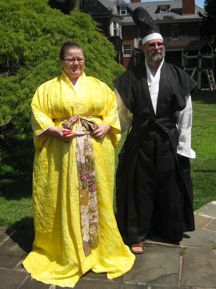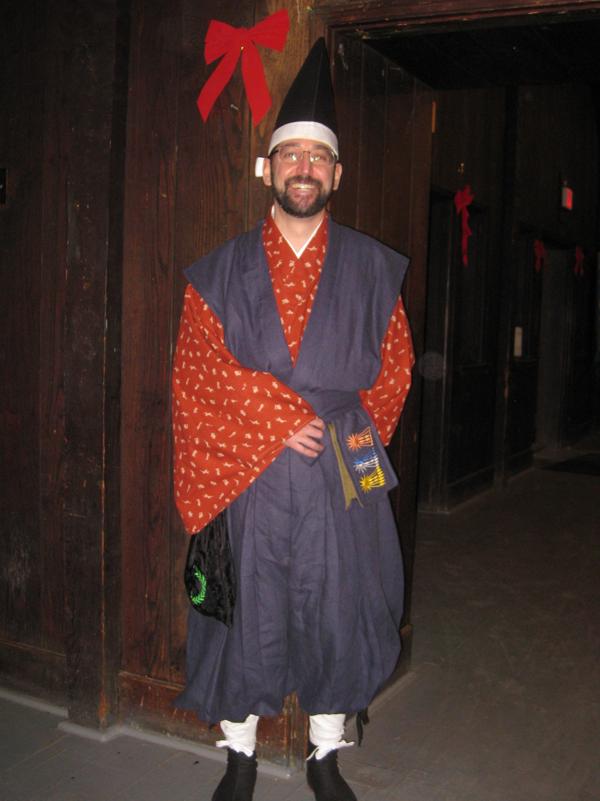Survey of Practical Japanese Garments
These garments are from mid to late period of the Japanese middle ages. That corresponds to Kamakura Period beginning in 1192 to Azuichi-Momoyama Period ending in 1603. In Japan, the fabric was narrow width about 18" wide. Because the fabric was narrow, clothing was constructed with multiple narrow panels sewn together lengthwise. In Edo period the fabric width was standardized to the modern even narrower width of 14".
The two most common garments are the kosode, short or long, and the hakama. I will discuss those two garments in a little more detail.
Kosode
Kosode means small sleeve. Actually, it means small sleeve opening. It is the precursor to the modern kimono.
It is not the same thing as a kimono and is not the same cut. The general differences are wider neckband and a more generous cut in the body. The kosode was an under-garment or peasant garment that became the common garment for even the upper class as time went on.
Some other points
-
The width of the sleeve panel should be the same as the width of the body. In a really fancy garment the sleeve width may only be 50-60% as wide as the body panel width and the body panel was very wide.
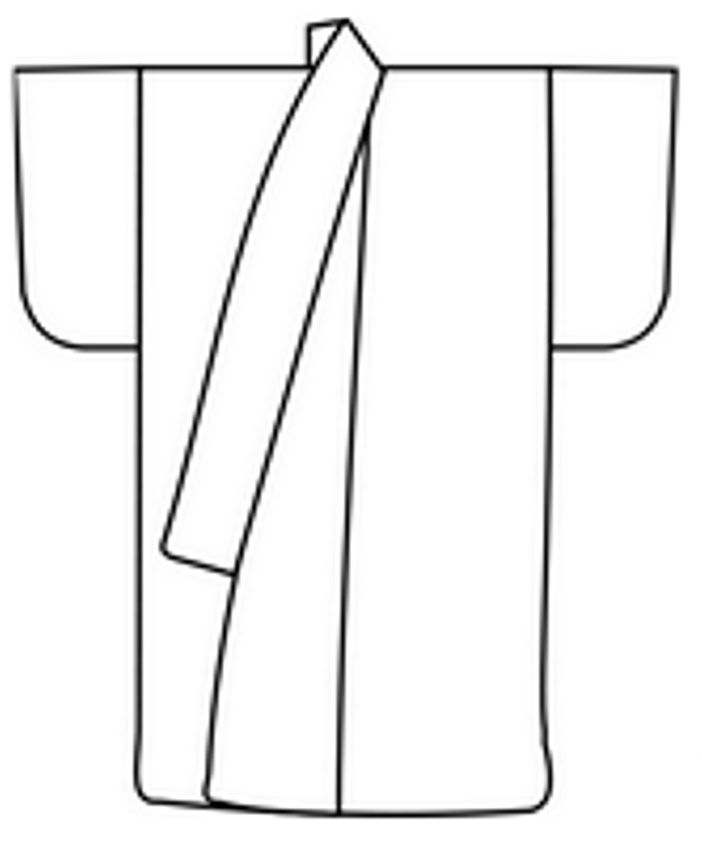
-
The neckband in middle class or upper class garments is about 5" wide. However, you fold it to the inside of the neckback at the neck so it doesn't come up to your ears.
-
The inner edge of the sleeves should attach to the body. The unattached sleeve is adapted for the modern wider obi. It is also used in children's clothing.
-
The okumi, or overlaps, don't attach vertically at the inner edge of the main body panel. They attach a few inches out very close to the width of the neck opening and about 4 inches down from the neck opening. They are also at a slight angle, so the bottom does come to the inside edge of the body panel.
- You wear a kosode with the left okumi over top of the right okumi.
- It is proper to have a seam up the back.
- You shouldn't wear just one kosode. The bottom-most layer of an outfit is the white kosode. Think of it as an undershirt. You wear one or more kosode over that bottom layer.
- Good reference for layout and construction. Oribe Tsukime's Kosode Patterns. The illustration above is from that site.
I am wearing a patterned uchikake over a blue kosode, over a white under kosode. The kosode is tied with an obi. The uchikake is a decorative top layer that has a longer body, a wider body panel, and narrower sleeve panel in proportion to the body panel, and has a wider neckband. You can see on the blue kosode how far down the body the neckband goes. Modern kimono neckbands do not go that far down.
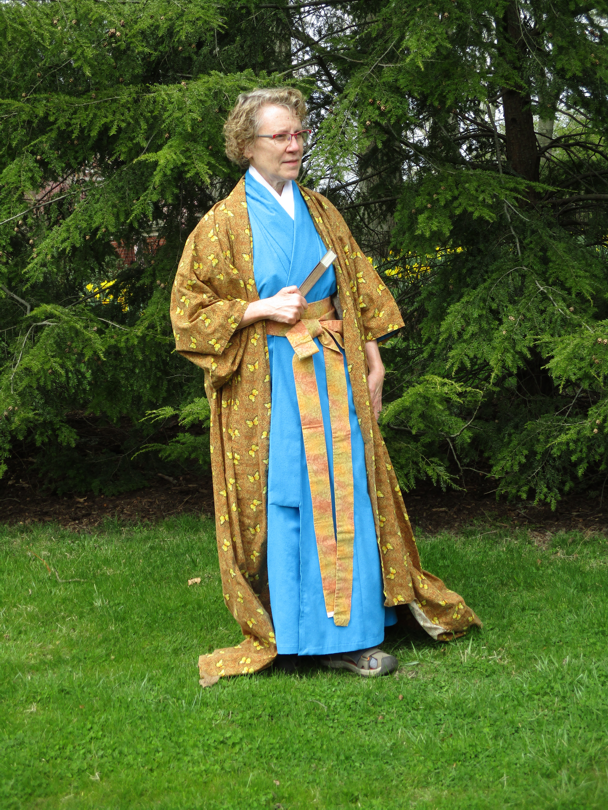
|
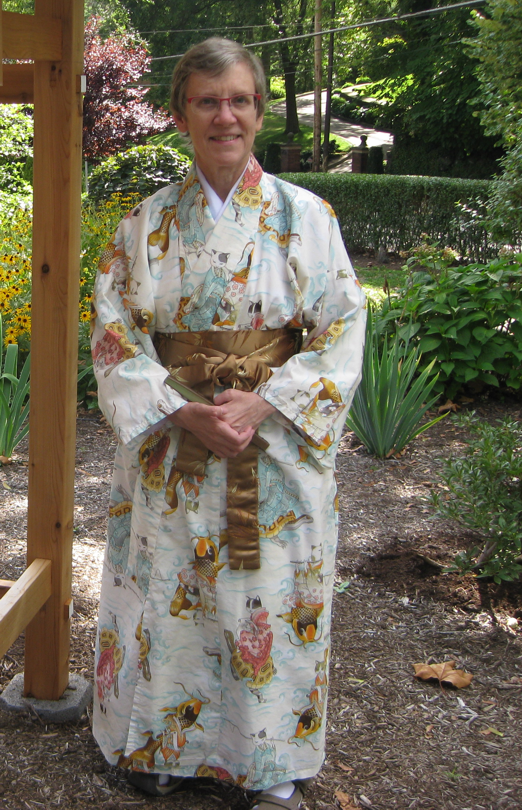
|
Short Kosode with Hakama
Same garment and a little shorter makes the top to this outfit.
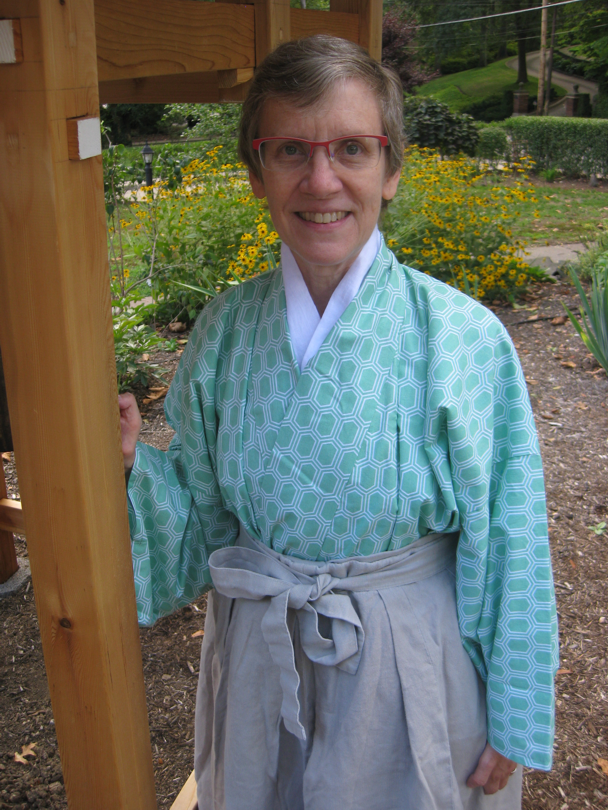
|
Hakama
Hakama are wide pleated flowing pants or a pleated skirt. Both variations are correct. I have pictures of both. These pictures of an outfit in the costume museum show good detail of the pleats, the side v-opening and how the himo or waistband is tied.
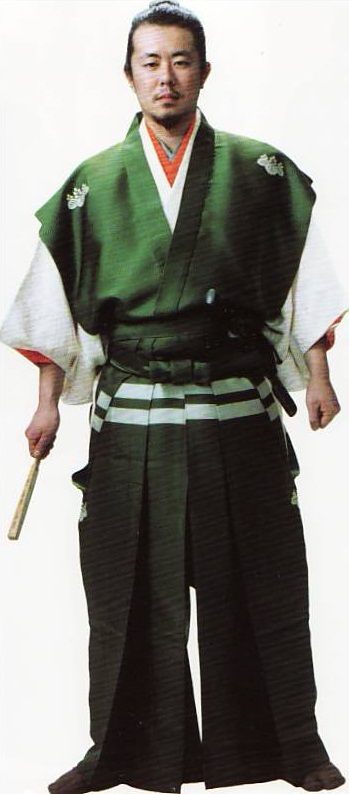
|
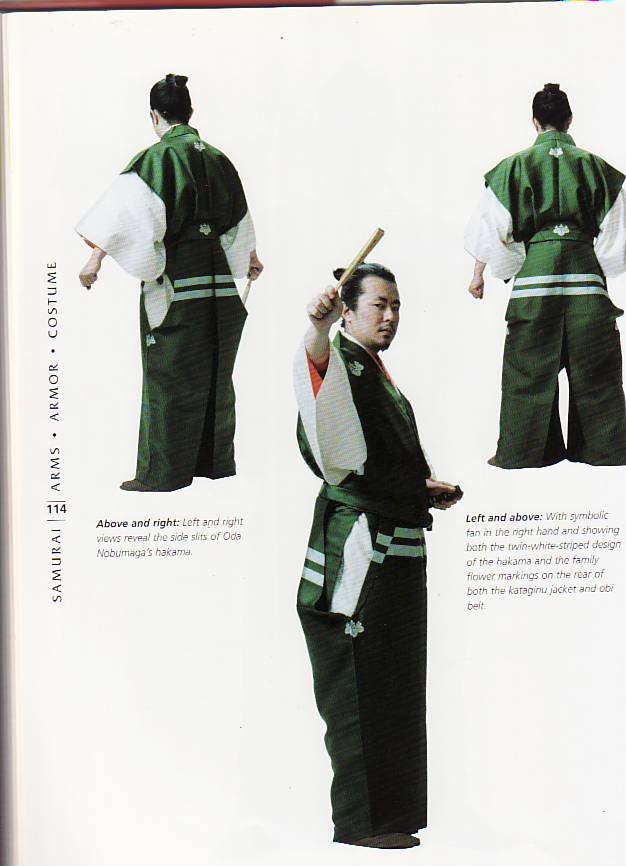
|
Some other points
-
The ties for the front are longer than the ties in the back because they loop completely around the waist. The back ties only come half way around to the front. The waistband ties both tie in the front. The back ties are under the front of the hakama.
-
The side seams of the hakama aren't sewn together up to the waistband, but stop mid-thigh. Note: The hem of the kosode and the kataginu should be below the bottom of that side v-opening. No skin should show in that side opening.
-
The inseams for the hakama pants use either a long strip of fabric or a gusset to join the front legs to the back legs to form separate leg openings. The long strip is the more common format in the middle-ages. The gusset uses less fabric and is less bulky.
-
The length of hakama are floor length or longer for upper class and court wear, but are shorter for middle class.
-
It is very appropriate to use leg wraps, kyahan, to get the flowing legs out of the way for various activities including martial activities.
Matching Kosode and Hakama Outfits
My husband and I are wearing matching kosode and hakama outfits. However, my hakama is a hakama skirt. You can't really tell it's a skirt and it is easier to deal with in a port-a-john.
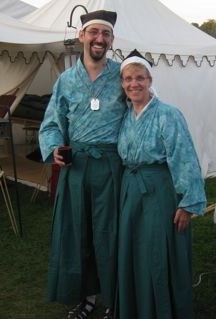
|
Short Kosode with Mobakama
Instead of a hakama skirt you can wear a mobakama, a wrap-around pleated skirt.
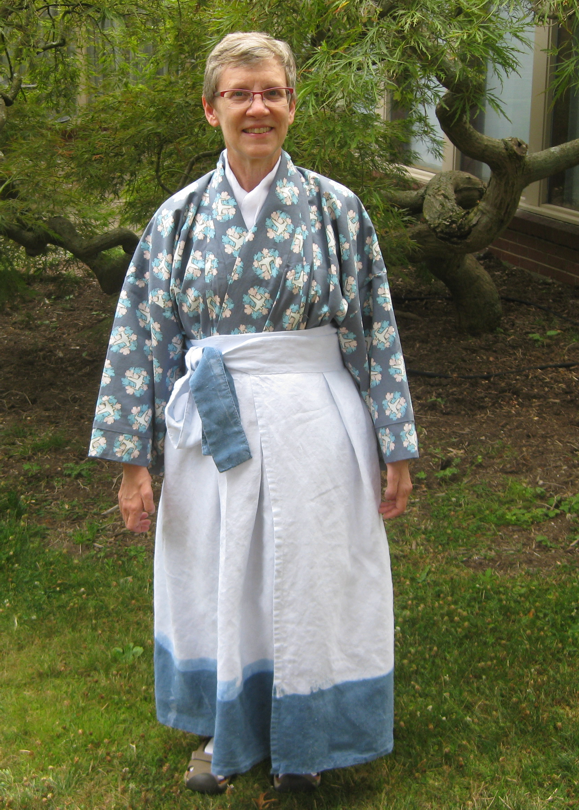
|
Long Kosode, Hakama, Kosode, and Kataginu
Baroness Hildarun is wearing long kosode over white under kosode tied with an obi. Baron Brandubh is wearing just a white kosode under the kataginu vest and the hakama pants.
Hakama, Kosode, and Kataginu
In this outfit, Ishiyama has the lower legs of the hakama wrapped with kyahan. These are good for keeping the fabric in the legs from getting in the way. He is wearing white kosode under the patterned kosode and the Kataginu vest with the ensemble.
Mompe and Hippari
Mompe or field pants are simple and less flowing. They also don't take much fabric. Hippari or a field top is post-period, but it uses less fabric and more confortable in the summer. The ties at the waist make it easier to keep the front closed without having to tuck your top in or wearing an obi. I found the folkwear pattern for these were very easy. Folkwear Japanese Field Clothing Pattern
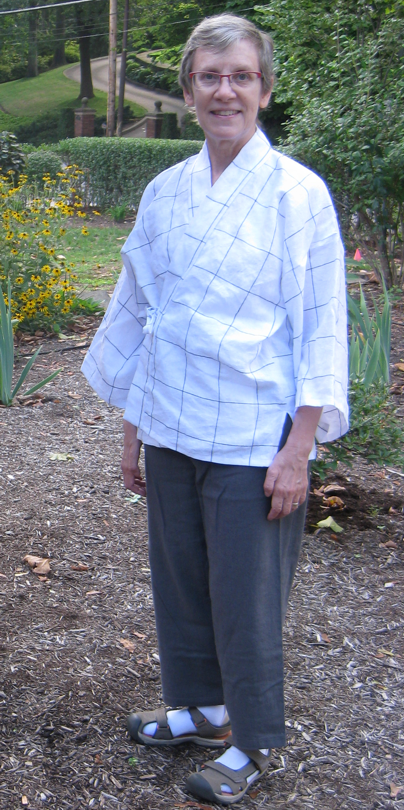
|
Dobuku
The dobuku was a middle-class garment that was adopted by Samurai. Think of it as a sport coat. It can be lined, lined and padded, or unlined. The top picture shows an unlined dobuku that I made for chilly but not too cold evenings.
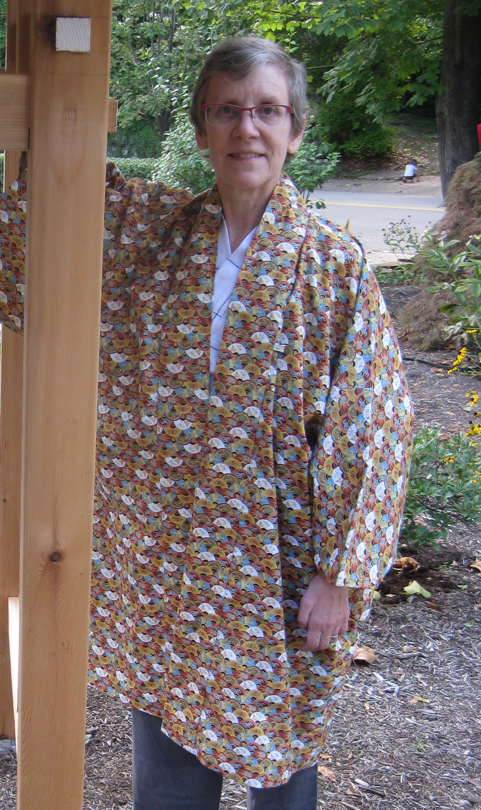
|
This dobuku isn't fancy, but it is silk body, silk lining, and cotton batting inside so it is warm. You can see it is a simple layout. There are no overlaps. There are the two body panels, the two sleeves and a neckband. The neckband comes straight down from the neck opening. The lining has two body panels and two sleeves, but not a neckband. John Marshall's book Make Your Own Japanese Clothes has very good instructions and pictures of how to construct lined garments.

|
These were our first fancy Japanese outfits. The padded jackets aren't quite right, but they looked good. Ishiyama is wearing hakama pants and I am wearing hakama skirt. You can't tell that it is a skirt.
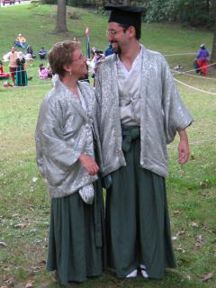
|
Hapi
Hapi is another post-period garment that is useful especially in evening or morning at Pennsic when it is a little chilly. It is the same sort of cut as the dobuku around the neck, but the sleeve is just a tube sleeve and only goes to the forearm not the wrist.
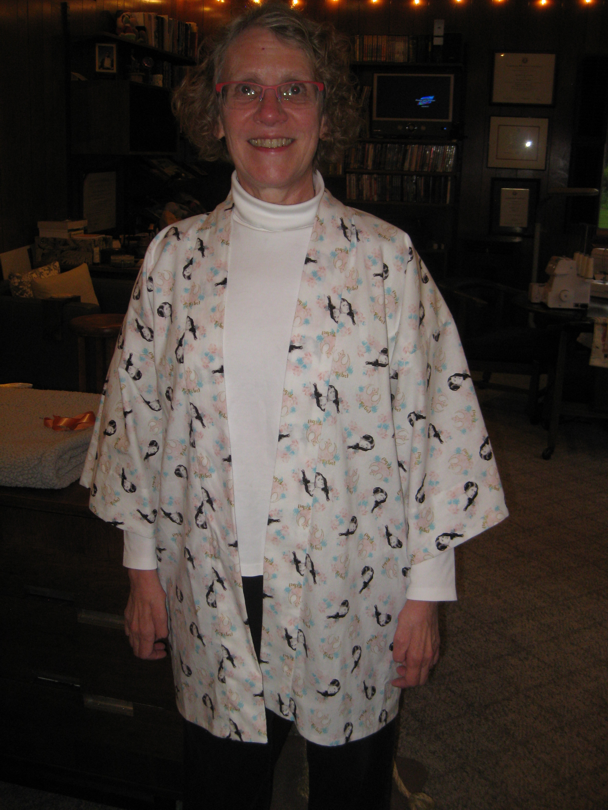
|
Accessories
There are all sorts of accessories. These are some of the common ones you see people wearing:
-
Straw hats. Here is an excellent reference page about this type of hat. sugegasa function and form history
-
Eboshi is the stand up shark-fin looking hat or the floppy hat. There are other types of eboshi as well.
-
Tabi are split toe socks.
-
Zori sandals
-
Geta are wooden shoes with two wooden teeth at the bottom. The tall teeth keep your feet out of the mud.
-
Waraji are traditional hand-woven straw sandals.
- Obi is the fabric waist tie. Typically it is between 2 and 4 inches wide for that time period. It wraps twice around your waist and is tied in front.
-
Kyahan are leg wraps. These can be rectangles or trapezoids with ties at the top and bottom. An alternate construction technique is to make a tube of fabric with ties at the top and bottom.
Bibliography
Oribe Tsukime's research and publications. Retrieved: June 16, 2022
Ishiyama Gen'tarou Yori-ie Japanese men's garments. Retrieved: June 16, 2022
Kure, Mitsuo. Samurai Arms Armor Costume. Edison: Chartwell Books, Inc, 2007.
Marshall, John. Make Your Own Japanese Clothes. Kodansha International: New York, NY, 1988.
The History of Women's Costume in Japan. Art Books Shikosha Publishing: Japan, 2003.
Folkwear Patterns Japanese Hapi and Haori Pattern . Retrieved: June 16, 2022
Folkwear Patterns Japanese Field Clothing Pattern. Retrieved: June 16, 2022









